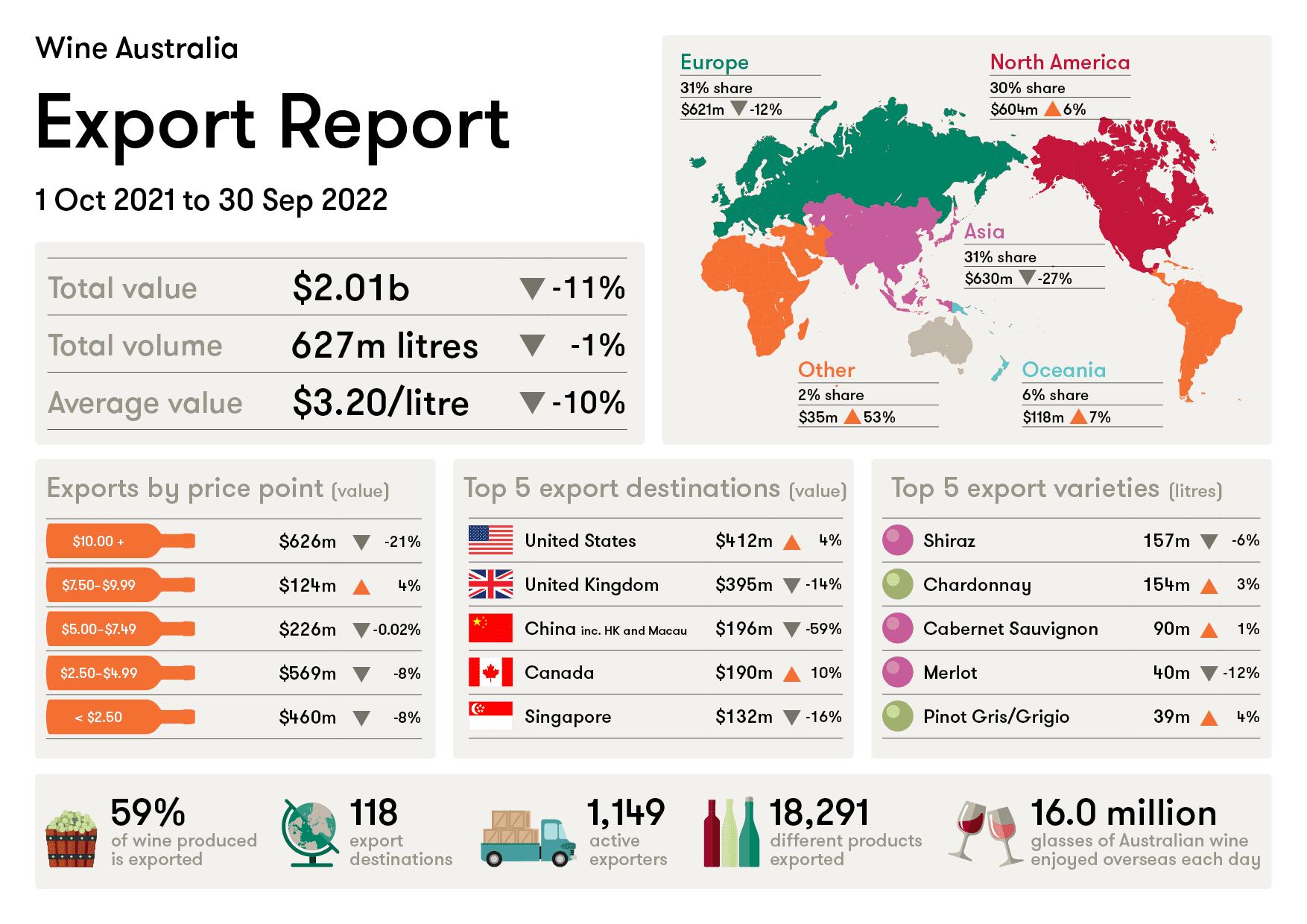
Australian wine exports declined by one percent in volume to 627 million litres and 11 percent in value to $2.01 billion in the year ended 30 September 2022, according to Wine Australia’s latest Export Report.
Wine Australia manager, Market Insights, Peter Bailey said the results were mixed with the increases recorded in some markets offset by declines in others.
“In this report, we’re seeing the tail end of the decline in exports to mainland China having an impact on the total export figures; this is expected to wash out of the figures by the end of 2022,” Mr Bailey said.
“When mainland China is excluded from the data, wine exports to the rest of the world held steady in value, declining by 0.2 percent to $1.99 billion and increasing by one percent in volume to 622 million litres.
“There was a decline in exports to the United Kingdom, Hong Kong and Singapore, which is a result of the return to anticipated shipment levels.
“This decline to the UK has been delayed compared to other markets with similar Covid-19 consumption patterns, such as the United States and Canada.
“Exports to the North America and Southeast Asia regions are showing growth. In particular, strong growth was recorded in exports to the US, Canada, Malaysia and Thailand.
“Pleasingly, the growth trend in the US and Canada was driven by both ends of the price spectrum; premium wine exports continued to grow and unpackaged commercial exports increased, as shipments of the record 2021 vintage accelerated following a slower than usual start due to global shipping pressures.”
The number of exporters to the US is at the highest level since 2008.
“And of the exporters to the US that ship wine at a value of $10 or more per litre free on board (FOB), 75 percent experienced growth demonstrating that green shoots continue in the market for premium Australian wine,” Mr Bailey said.
“However, while total exports look to be stabilising, the wine sector can continue to expect market fluctuations, as rising inflation and interest rates may put pressure on margins and curtail consumer spending in key markets.
“On a positive note, over the past few months, the Australian dollar has depreciated against the US dollar, which assists Australian wineries to be more competitive in the US.”
Australian wine exporters shipped to 118 destinations during the period, up from 111 the previous year.
The strongest growth came from North America, up six percent to $604 million, and Southeast Asia (up 15 percent to $291 million).
However, the large decline to Northeast Asia (down 46 percent to $321 million, driven by mainland China) and to Europe (down 12 percent to $621 million, driven by the UK’s return to more normal shipping levels) outweighed the growth to other regions.
 The top five markets by value were:
The top five markets by value were:
- US (up 5 percent to $412 million – 21 percent share of total export value)
- UK (down 14 percent to $395 million – 20 percent share of total export value)
- Canada (up 10 percent to $190 million – 10 percent share of total export value)
- Hong Kong (down 21 percent to $163 million – 8 percent share of total export value), and
- Singapore (down 16 percent to $132 million – 7 percent share of total export value).
The top five markets by volume were:
- UK (down 12 percent to 222 million litres – 36 percent share of total export volume)
- US (up 14 percent to 139 million litres – 22 percent share of total export volume)
- Canada (up 26 percent to 62 million litres – 10 percent share of total export volume)
- New Zealand (up 14 percent to 32 million litres – 5 percent share of total export volume), and
- Germany (down 7 percent to 31 million litres – 5 percent share of total export volume).
North America
Exports to the US increased by five percent in value to $412 million and 14 percent in volume to 139 million litres. There are several drivers of the growth. One of which is that the volume of unpackaged wine shipped to the US increased by 53 percent to 68 million litres during the period. The substantial size of this increase is because the Australian 2021 vintage was the largest on record and the shipments of this vintage had been delayed due to the ongoing global freight challenges. In the past few months, shipments of this vintage have intensified.
Secondly, packaged wine declined by one percent in value to $319 million and nine percent in volume to 71 million litres. As volume declined more than value, the average value of packaged wine increased by nine percent $4.47 per litre FOB. Driving this increase in average value is the decline of packaged commercial wines (mainly the $2.50 to $4.99 price segment) and an increase in exports above $7.50 per litre FOB, up 32 percent to $71 million.
Wine exports to Canada increased by 10 percent in value to $190 million and 26 percent in volume 62 million litres. The largest driver of the increase in volume was growth in unpackaged wine shipments. The volume of unpackaged shipments increased by 44 percent to 36 million litres.
The increase in total value of exports to Canada was driven by packaged shipments, especially at the premium end. The value of packaged shipments increased by 11 percent to $156 million while volume increased by seven percent to 26 million litres. Shipments valued at $5 per litre FOB and above grew by 18 percent in value to $122 million, the highest value for this price segment since 2009.
United Kingdom
Exports to the UK decreased by 14 percent in value to $395 million and 12 per cent in volume to 222 million litres. This decline in wine exports to the UK was expected, if somewhat delayed. There were two factors elevating exports to the UK since 2020. Firstly, the Brexit transition period saw an increase in exports ahead of the 31 December 2020 deadline. Secondly, Australian wine holds the number one position in the off-trade – a category that benefitted greatly from the closure of the on-trade during the COVID-19 pandemic, and now, as the on-trade has opened back up, there is a counter-swing in the demand for Australian wine. While this counter-swing occurred much earlier in the US and Canada, another two markets where Australia has a larger share of the off-trade than on-trade, the shift has been much slower in the UK and exports are only now starting to be affected.
Asia
Exports to Northeast Asia declined by 46 percent in value $321 million and by 31 percent in volume to 35 million litres. The main contributor to this decline was exports to mainland China (down 92 percent to $21 million) and exports to Hong Kong (down 21 percent to $163 million). Exports to Hong Kong are returning to a more normal level after an increase in shipments to the market in 2021. Offsetting some of the declines were exports to Japan and Taiwan, which rose by 18 percent and 13 percent respectively. Exports to South Korea dropped by five percent in value to $43 million; the decline took place in exports valued below $7.50 per litre FOB (down 44 percent), while exports above $7.50 per litre increased by 30 percent.
Exports to Southeast Asia increased by 15 percent in value to $291 million and 39 percent in volume to 24 million litres. Several markets increased in value, including Thailand (up 95 percent to $53 million) and Malaysia (up 55 percent to $59 million). This growth was slightly offset by a decline in exports to Singapore, dropping 16 percent to $132 million; shipments to Singapore are also normalising after an elevated level of shipments in 2021 and 2022.
Photo by Timelab Pro on Unsplashed.
Related content









Recent Comments